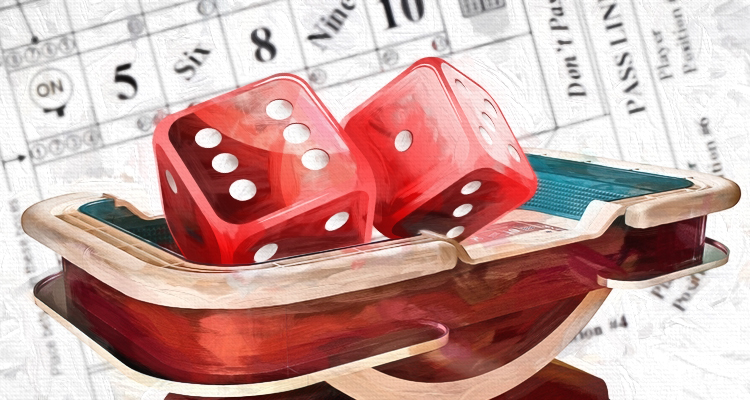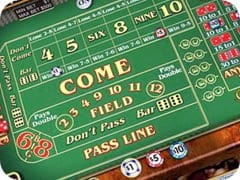- Rhythmic Rolling Craps Game
- Rhythmic Rolling Craps Games
- Rhythmic Rolling Craps Rules
- Rhythmic Rolling Craps Machine
A Simple One-Two Craps Punch! By Frank Scoblete
Craps is a dice game in which the players make wagers on the outcome of the roll, or a series of rolls, of a pair of dice. Players may wager money against each other (playing 'street craps') or a bank (playing 'casino craps', also known as 'table craps', or often just 'craps'). Probably the Captain's long-run success at craps using the 5-Count has to do with the existence of rhythmic rollers. The 5-Count allows us to be there for extended periods of time, so that when these individuals show up we haven't lost so much that we can't come roaring back. So, yes, I am a believer. How to Play Craps. Craps is a game where many bettors get to stake their chips on a roll of the dice. The table layout makes the game seem a little confusing at first, but the rules are easy to pick up with experience. Craps trends derived from the controlled throws of a rhythmic roller is a different story. This is when craps trends begin to make sense and have meaning. Rythmic rollers are skilled dice controllers that have developed the knack for almost accurately influencing dice results at will.
Craps is unique among casino games. It is the only game in the casino where the house gives the player the dice and says: 'Here, beat us if you can.' In blackjack, the casino doesn’t hand you the cards and say: 'Here, shuffle and deal and decide how you’ll play the house hands.' In roulette, you don’t get to pump the wheel and spin the ball and try to hit your numbers. Even in traditional baccarat, where you get to deal, you have no say in the shuffle or play of the hands – in short, your dealing is window dressing. In all other casino games, you are an onlooker to Lady Luck’s seductive dance; in craps, you’re her dance mate and her partner.
Craps can be divided into two separate games. There’s the mathematical game based on the probabilities inherent in two six-sided dice and there’s the physical game where people roll the dice. The former is the gold standard where making the best possible bets is the key element. The latter is the stock market, where millions can be won by savvy investors.

If you are a novice craps player and you look at the layout, it can be baffling – squiggles, designs, numbers, symbols. Checking out the action at a craps table can be frightening – it’s a game with its own unique and extensive language; it own rigorously imposed customs and superstitions. And a gazillion bets, mostly bad.


Yet, stripped of its makeup, language and dress, craps is plain and simple.
The shooter places a bet on the Pass Line and is given the dice; this is called the 'come-out' roll. He wants to roll a 7 or 11, instant winners; avoid the 2, 3, or 12, instant losers, or establish a 'point,' that is, one of the following numbers: 4, 5, 6, 8, 9, or 10. If he establishes a point, he must hit that point before he rolls a 7 in order to win. If he rolls a 7 before he rolls his point, he – and everyone who bet on the Pass Line – loses. That’s the game.
Add to the Pass Line bet the Come bet, which is made after the point is established, and follows the exact same rules as the Pass Line bet, and you have the two best bets of the game.
Yes, you can complicate things by throwing in the Don’t Pass/Don’t Come options but we won’t as only a tiny minority of despised players approach the game from this angle. Suffive it to say that if you are starting to play craps for the first time, you’ll be nervous enough at the table. You won’t need the other players glaring at you which is exactly what they’ll do if you play the Don’t Pass or Don’t Come.
Rhythmic Rolling Craps Game
Pass and Come are good bets as the house has an approximately 1.4 percent edge on each. What does such an edge mean? Simply that for every $100 wagered on the Pass or Come, you long-run expectation will be a loss of $1.40. Not too bad. That edge can be further reduced by taking 'odds' on the point number. The odds is a bet that can be equal to or more than the amount you have on the Pass or Come. If you are betting $5, and the casino where you are playing allows double odds, you can place $10 in odds behind your Pass or Come bet. The house pays this bet off at 'true odds' and therefore has no edge on the bet.
Making that Pass Line and Come bets and backing them with odds gives you a solid mathematical approach. There are also some other good betting options. You can 'Place' the 6 and/or 8 in multiples of $6 and, if you win on either, you’ll get paid $7. The house edge on this is a low 1.5 percent. In Vegas and Mississippi casinos, you can 'buy' the 4 and/or 10 by paying a commission of five percent when the bet wins. The house edge on a $25 buy bet is around 1.3 percent. (This type of 'buy' is not available in Atlantic City – there you must pay the five percent commission whether the bet wins or loses, almost tripling the house’s edge.) In Tunica you can buy the 5 and 9 and only pay a $1 commission if the bet wins. That reduces the house edge to about 1 percent.
The physical game of craps contains a controversial area that is just now beginning to reach the consciousness of some craps players. When the casino hands you the dice, it has created a set of rules and a table structure intended to randomize the roll. You have to hit the back wall where foam rubber pyramids deflect the dice. The casino expects that the shooters have no real influence over the dice once they leave his hand. Most gaming writers agree that craps is random and that shooters do not have any influence. However, I think that certain shooters have, through practice and/or extensive play, refined their rolling to the point where they have enough influence over the dice to change a slightly negative game (when you make the good bets) to a slightly positive game. This concept is called 'rhythmic rolling' or 'dice control' and involves setting the dice and delivering the dice in a consistent fashion.
Rhythmic Rolling Craps Games

If I am right about rhythmic rolling then the right one-two punch of craps becomes clear.
Punch 1. Make the bets with the lowest house edges, Pass and Come
Rhythmic Rolling Craps Rules
Punch 2. Learn how to deliver the dice to influence the outcome in your favor.
Rhythmic Rolling Craps Machine
Do these two steps and you might just score a craps knockout!
Frank Scoblete is the #1 best-selling gaming author. His books and tapes have sold over a million copies. He is executive director of Golden Touch™ Craps dice-control seminars. His websites are www.scoblete.com and www.goldentouchcraps.com . For a free brochure or more information call: 1-800-944-0406 or write to: Paone Press, Box 610, Lynbrook, NY 11563
